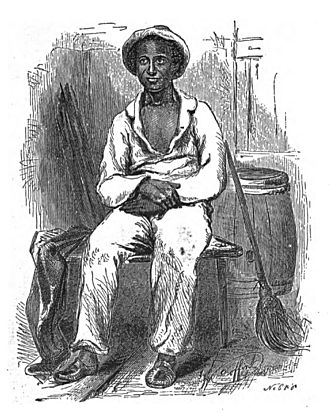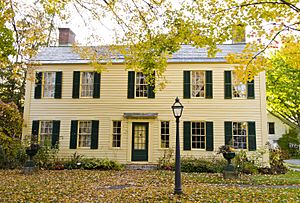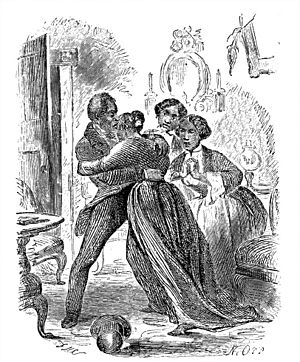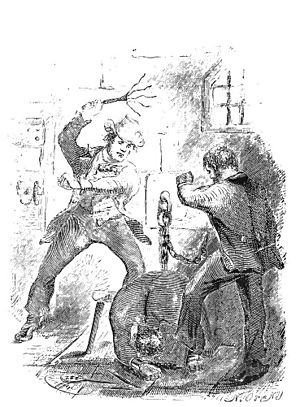Solomon Northup facts for kids
Quick facts for kids
Solomon Northup
|
|
|---|---|

Engraving from his autobiography
|
|
| Born |
Solomon Northup
July 10, c. 1807 or 1808 Minerva, New York, U.S.
|
| Died | between 1857 and 1875 |
| Occupation |
Author
|
| Known for | Writing Twelve Years a Slave |
| Signature | |
Solomon Northup (born around July 10, 1807 or 1808) was an American writer and activist. He fought against slavery. He is famous for writing his life story, Twelve Years a Slave.
Solomon was born a free African American in New York. His father was a freed slave, and his mother was a free woman of color. Solomon was a farmer and a talented violin player. He owned land in Washington County, New York.
In 1841, he was tricked with a job offer as a traveling musician. He went to Washington, D.C., where slavery was legal. There, he was kidnapped and sold into slavery. He was sent to New Orleans and bought by a plantation owner. Solomon was held as a slave for 12 years in Louisiana.
He finally met Samuel Bass, a Canadian worker. Bass helped Solomon send a message to New York. New York law helped free citizens who were kidnapped. His family and friends got help from the Governor of New York, Washington Hunt. Solomon Northup became free again on January 3, 1853.
The slave trader who kidnapped him, James H. Birch, was arrested. But he was found not guilty. This was because black people could not speak against white people in court in Washington, D.C. Later, in New York, the people who kidnapped him were charged. But the case was stopped because of legal issues. No one was punished for kidnapping Solomon.
After being freed, Solomon wrote his book, Twelve Years a Slave (1853). He gave many speeches to support the movement to end slavery. He spoke about his terrible experiences. Solomon Northup mostly disappeared from records after 1857. Some thought he was kidnapped again, but historians think this is unlikely. He would have been too old to be sold for much money. No one knows exactly when or how he died.
Solomon Northup's book was made into a TV movie in 1984. It was called Solomon Northup's Odyssey. In 2013, it became a major film, 12 Years a Slave. This film won three Academy Awards, including Best Picture.
Contents
Solomon's Early Life
Solomon Northup was born in Minerva, New York. This was on July 10, 1807, or July 10, 1808. His mother was a free woman of color. This meant Solomon and his older brother, Joseph, were born free. This was based on a law called partus sequitur ventrem. This law said that children born to a free mother were also free. Solomon said his mother was "quadroon." This meant she was one-quarter African and three-quarters European.
His father, Mintus, was a freedman. This means he had been a slave earlier in his life. He worked for the Northup family. Mintus was born in Rhode Island. He moved with the Northups to Hoosick, New York. His owner, Henry Northrop, freed Mintus in his will. After being freed, Mintus took the last name Northup. He then married and moved to Minerva with his wife.
Solomon said his father was "respected for his hard work and honesty." Mintus was a successful farmer. He owned land, which allowed him to vote. Solomon and his brother got a good education for free black people at that time. As boys, they worked on the family farm. Solomon loved playing the violin and reading books.

Mintus moved his family to Washington County, New York. They worked on farms owned by the Northups. They lived in Granville for several years. Then they moved to Alden Farm near Sandy Hill. Later, they moved east of Fort Edward. Mintus lived there until he died on November 22, 1829. He was buried in Hudson Falls. Solomon's mother died while he was enslaved, around 1846 or 1847.
Marriage and Family Life
Solomon Northup married Anne Hampton on December 25, 1829. This was one month after his father died. Some records say they married on December 25, 1828. They were married in Fort Edward. Anne was born on March 14, 1808. She grew up in Sandy Hill. She was a "woman of color" with African, European, and Native American roots. They had three children: Elizabeth (born around 1831), Margaret (born around 1833), and Alonzo (born around 1835).
When they first married, they lived in Fort Edward. In 1830, they moved to Kingsbury. Both were small towns in Washington County, New York. In 1834, they sold their farm. The Northups moved to Saratoga Springs, New York, about 20 miles away. They hoped to find more work there.
Anne was a great cook. She worked at local restaurants and hotels. She cooked at the United States Hotel. She also worked at Sherrill's Coffee House in Sandy Hill.
After Solomon was kidnapped, Anne and Elizabeth worked as housekeepers in New York City. This was in the summer of 1841. Their son, Alonzo, was with them. Margaret, their youngest daughter, went to live with a friend in Hoboken, New Jersey.
After about two years, Anne brought the family back together in Saratoga. She worked as a cook in hotels there. In 1852, she learned what happened to her husband. She asked Henry B. Northup for help to free him. She gave a statement to a judge on November 19, 1852. Henry B. Northup gathered proof that Solomon was free. He then went to Louisiana to bring him home.
Solomon returned to Sandy Hill on January 21, 1853. He was reunited with his wife and children. By 1855, he lived with his daughter Margaret and her family in Queensbury. He bought land near his daughter in Glens Falls. In his book, Solomon wrote about his deep love for his wife and children.
While Solomon gave talks about his book, Anne worked at a hotel in Bolton Landing. Author David Fiske says Solomon struggled after his years in slavery. By the late 1850s, no one knew what happened to Solomon. He was not listed with his family in the 1860 census.
Anne Northup later lived with her daughter Margaret and son-in-law Philip Stanton. She did laundry, cooking, and chores. In 1870, she worked as a cook at a hotel in Sandy Hill. Anne Northup lived in Kingsbury in 1875. By then, she was called a widow. She died in 1876. One newspaper said Solomon became a "worthless vagabond" after showing himself around the country.
Solomon's Occupations
In the winter of his marriage year, Solomon worked on the Champlain Canal. He then bought two horses. He used them to pull rafts of lumber to Troy. This work started in the spring. He hired two workers. He also worked on other waterways in New York. He traveled to northern New York and Montreal, Canada. When the canal closed for winter, he cut lumber. He also worked as a farm laborer.
He farmed corn and oats on part of the Alden farm. He became a well-known fiddler. People often asked him to play for dances. He and Anne became successful. Anne earned money as a cook, and Solomon earned money from farming and playing music.
In March 1834, the couple moved to Saratoga Springs. Solomon drove a horse-drawn taxi. During the busy tourist season, he worked at the United States Hotel. He played his violin at several famous hotels. He also helped build the Troy and Saratoga Railroad. He became friends with local shop owners. For seven years, the Northups managed to live comfortably. But they did not become as rich as they hoped.
In March 1841, Anne went to Sandy Hill. She managed the kitchen at Sherrill's Coffee House. Their oldest daughter, Elizabeth, may have gone with her. Their two youngest children stayed with their aunt. Solomon stayed in Saratoga Springs to find work until the tourist season.
Gaining Freedom Again
Bass wrote letters to people Solomon knew in Saratoga Springs. One went to his old boss, Judge James M. Marvin. Another went to Cephas Parker and William Perry, who owned stores. Parker and Perry sent the letter to Solomon's wife, Anne. Anne then contacted Henry B. Northup, a lawyer. Henry B. Northup was the son of Solomon's father's former owner.
Henry B. Northup contacted the Governor of New York, Washington Hunt. The governor took on the case. He made the state's lawyer his legal helper. In 1840, New York State passed a law. It said the state would help any free black residents kidnapped into slavery. It also promised a jury trial for people accused of being runaway slaves.
Once Solomon's family knew, his rescuers had to find him. Solomon had hidden his location in case the letters were found. Bass also did not use his real name. They needed proof that Solomon was a free citizen of New York. Henry B. Northup also collected sworn statements from people who knew Solomon. During this time, Solomon did not know if Bass's letters reached anyone. They had to keep their plans secret.
Henry gathered documents and statements. He stopped in Washington, D.C. He met with a Louisiana lawmaker and the Secretary of War. This was to prepare for the rescue in Louisiana. Even without Bass's name, Henry found him in Marksville. Bass told him that Solomon Northup was held by Edwin Epps. Henry had legal papers ready. The sheriff went with Henry to tell Epps and take Solomon from the farm.
Solomon later wrote, "He [Epps] thought only of his loss." He cursed Solomon for being born free. Henry B. Northup convinced Epps that fighting the freedom papers in court was useless. So, the plantation owner gave up his claim to Solomon. Finally, on January 4, 1853, Solomon became free again. This was four months after meeting Bass.
His Book: Twelve Years a Slave
After returning to New York, Solomon Northup wrote and published his book. It was called Twelve Years a Slave (1853). He wrote the book in three months. He had help from David Wilson, a local lawyer and writer.
Solomon told the story of his kidnapping and slavery. He included many details that could be checked. He described the cruelty he faced. He also shared acts of kindness he received. The Rome Citizen newspaper said, "Its tone is much milder than we expected." The details he gave helped show what life was like on a plantation.
Sue Eakin and Joseph Logsdon checked the facts in Solomon's book. They confirmed many events and people. They published their updated version of the book in 1968. Edwin Epps, his slave owner, told soldiers during the Civil War that most of the book was true. Solomon could read and write. He gave facts simply and honestly. Wilson helped with the writing style and grammar.
The book was published by Derby & Miller in Auburn, New York. At that time, slavery was a big topic. The novel Uncle Tom's Cabin (1852) was very popular. Solomon's book also became a bestseller. It sold 30,000 copies in three years. Solomon traveled and gave talks in the Northeast. He told his story and sold books. His book became the basis for other books about him.
Court Cases and Later Life
Solomon Northup was one of the few free black people kidnapped into slavery who regained freedom. He was represented by lawyers, including Senator Salmon P. Chase. Solomon sued Birch and others who sold him into slavery in Washington, D.C. Historian Carol Wilson found 300 kidnapping cases like his. She believes thousands more were kidnapped but never recorded.
As Solomon and Henry Northup returned to New York, they stopped in Washington, D.C. They filed a complaint against James H. Birch. Birch was arrested and tried. But Solomon could not speak in court because of D.C. laws. Birch and other slave traders said Solomon claimed to be a slave from Georgia. Birch's records did not show he bought Solomon. Henry B. Northup and another white man said they knew Solomon for years. They said he was born free in New York. Since no one could legally speak against Birch, he was found not guilty. But the case became famous. The New York Times wrote about it on January 20, 1853.
The New York trial began on October 4, 1854. Solomon and another person testified against two men. The case showed illegal practices in the slave trade. Details from Solomon's story were confirmed during the trial. Lawyers argued if the crime happened in New York or D.C. After two years of appeals, the case was dropped in May 1857.
Solomon worked as a carpenter after moving back to New York. He became active in the movement to end slavery. He gave talks about slavery before the American Civil War. In the summer of 1857, Solomon was in Canada for talks. In Streetsville, Ontario, a hostile crowd stopped him from speaking.
After 1857, he was not living with his family. Some thought he was enslaved again. But historians Clifford Brown and Carol Wilson think he likely died naturally. He was too old for slave catchers to be interested.
A minister named John R. Smith wrote letters in the 1930s. He said his father worked with Solomon Northup in the early 1860s. They helped runaway slaves on the Underground Railroad. Solomon was said to have visited Rev. Smith after Lincoln's Emancipation Proclamation in January 1863.
There are no records of his death. Historians believe he died in 1863 or 1864.
How Scholars View His Story
Solomon's book is often called a slave narrative. But scholar Sam Worley says it is different from others. Solomon had help writing it from David Wilson, a white man. Some thought Wilson might have changed the story. But Worley said Wilson was not trying to serve his own interests.
Worley wrote that Twelve Years is clearly Solomon's story. It pays great attention to facts. It does not simplify his complex experience. Solomon's biographer, David Fiske, says the book is truly Solomon's. Solomon's detailed story has helped many historians study slavery. His description of the "Yellow House" (a slave prison) helped researchers. It helped them understand the history of slavery in Washington, D.C.
- Ulrich Bonnell Phillips (a historian) doubted most slave stories. But he called Solomon's book "a vivid account of plantation life from the under side."
- Scholar Kenneth M. Stampp often used Solomon's book in his own book on slavery.
- Stanley Elkins also found Solomon's book to be historically true.
- Since the mid-1900s, there has been new interest in Solomon's book. This is due to the civil rights movement and studies of African-American history.
- The first scholarly version of the book was published in 1968. It was edited by professors Sue Eakin and Joseph Logsdon. This version is still used by students and scholars today.
- In 1998, students at Union College studied Solomon's story. They collected photos, family trees, and maps. Their exhibit showed this material.
- Jesse Holland used Solomon's story in his book Black Men Built the Capitol (2007).
Legacy and Honors
- In 1999, Saratoga Springs put up a historical marker for Solomon. The city made the third Saturday in July "Solomon Northup Day." This day honors him and teaches about freedom and justice.
- In 2000, the Library of Congress added Solomon Northup Day to its archives. Other groups have also recognized this event. "Solomon Northup Day – a Celebration of Freedom" still happens every year.
- Annual events honor Solomon Northup. A 2015 meeting at Skidmore College brought together Solomon's descendants.
In Movies and Music
- Poet Rita Dove wrote a poem about Solomon called "The Abduction." It was in her book The Yellow House on the Corner (1980).
- In 1984, Twelve Years a Slave became a PBS TV movie. It was called Solomon Northup's Odyssey. Avery Brooks played Solomon.
- In 2008, musician T. K. Blue created music inspired by Solomon's life. It was called Follow the North Star.
- An episode of the 2010 TV show America: The Story of Us showed Solomon's slave auction. It focused on a mother being separated from her children. The actor playing Solomon read parts from his book.
- The 2013 movie 12 Years a Slave was based on his book. It was directed by Steve McQueen. Chiwetel Ejiofor played Solomon. He was nominated for an Oscar. The film won three Academy Awards. These included Best Picture and Best Supporting Actress for Lupita Nyong'o.
Images for kids
See also
 In Spanish: Solomon Northup para niños
In Spanish: Solomon Northup para niños





